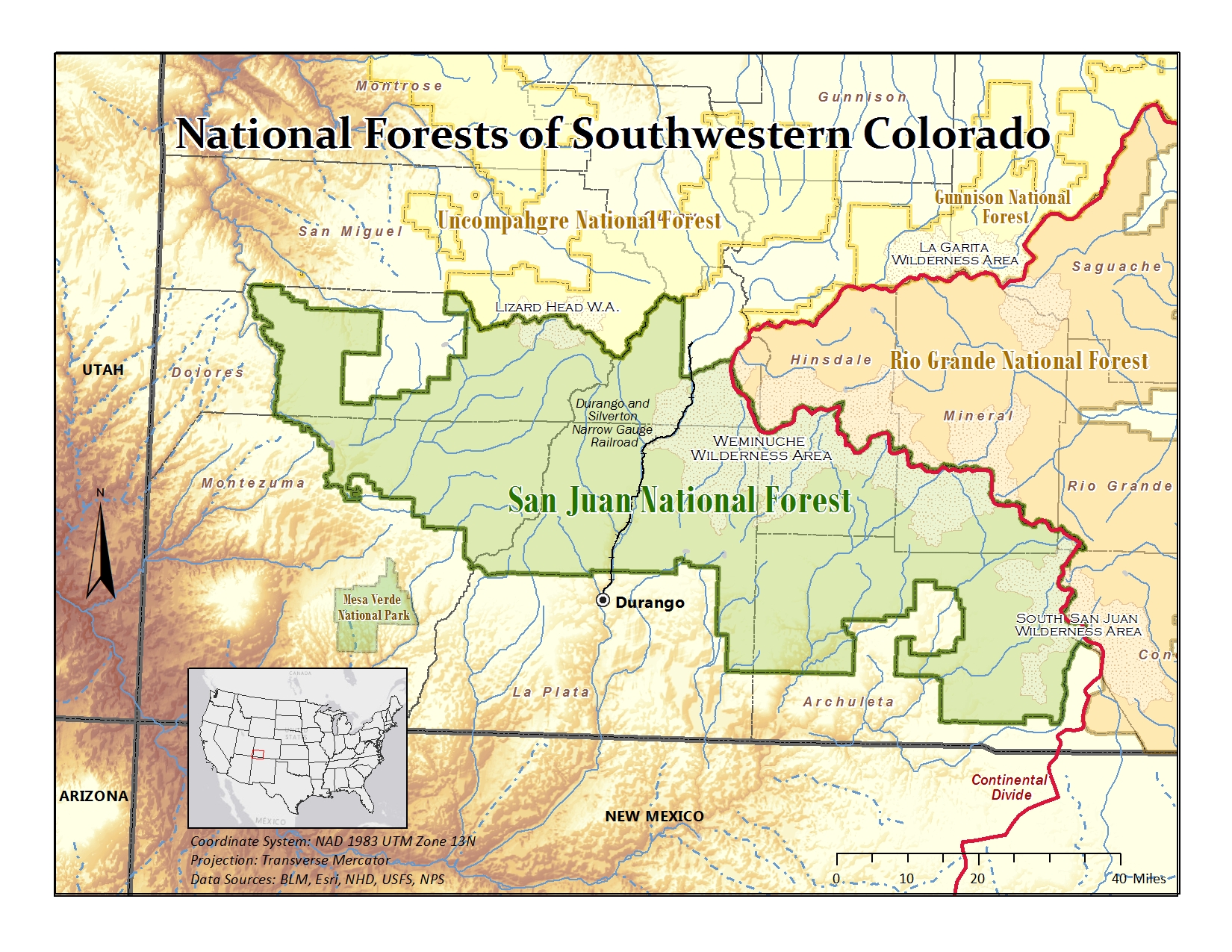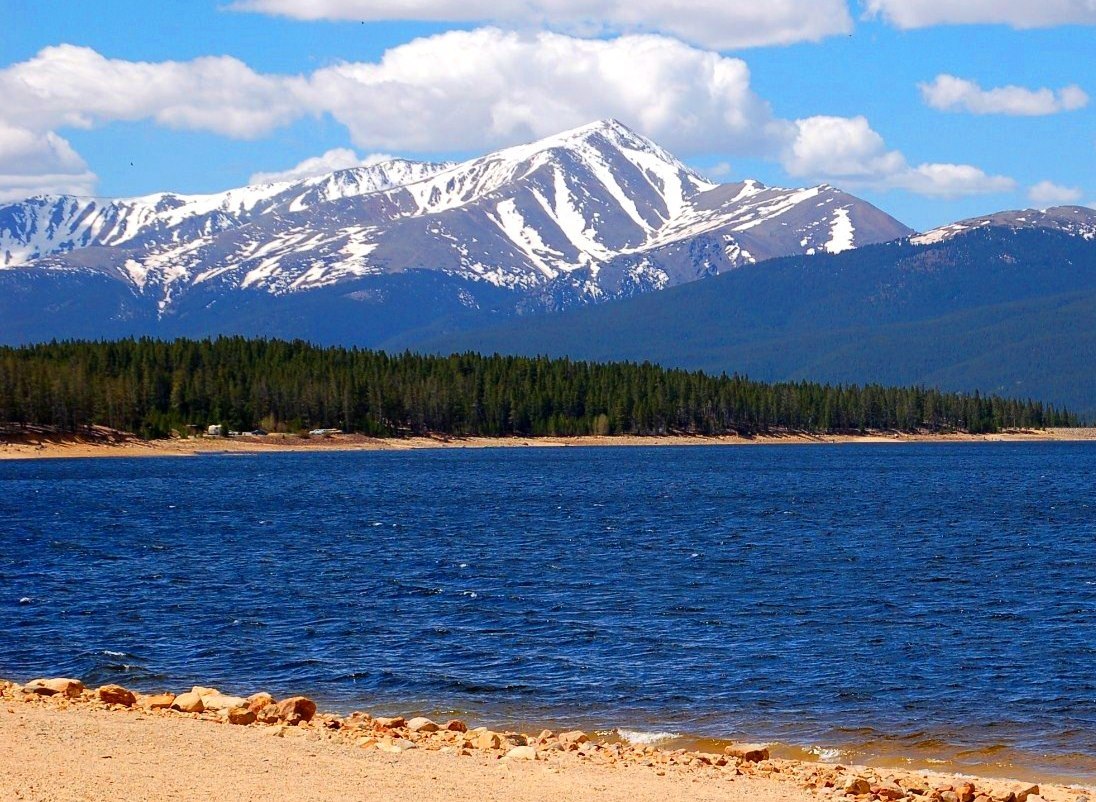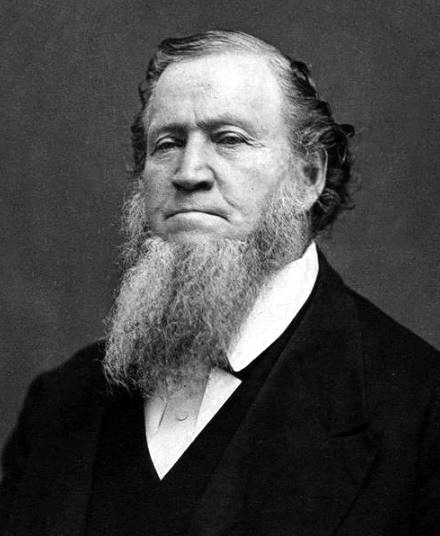|
Hesperus Mountain (Colorado)
Hesperus Mountain (Navajo: meaning "Big Mountain Sheep") is the highest summit of the La Plata Mountains range of the Rocky Mountains of North America. The prominent thirteener is located in San Juan National Forest, northeast by east ( bearing 59°) of the Town of Mancos in Montezuma County, Colorado, United States. The summit of Hesperus Mountain is the highest point in Montezuma County. Mountain Though not of particularly high elevation for the region, Hesperus Mountain is visually quite prominent, as it is near the southern edge of the San Juan Mountains and rises over above the area. Hesperus is notable as the Navajo People's Sacred Mountain of the North, ', which marks the northern boundary of the Dinetah, their traditional homeland. It is associated with the color black, and is said to be impregnated with jet. When First Man created the mountain as a replica of mountains in the Fourth World, he fastened it to the ground with a rainbow and covered it in darknes ... [...More Info...] [...Related Items...] OR: [Wikipedia] [Google] [Baidu] |
Sea Level Datum Of 1929
The National Geodetic Vertical Datum of 1929 is the official name since 1973 of the vertical datum established for vertical control surveying in the United States, United States of America by the General Adjustment of 1929. Originally known as Sea Level Datum of 1929, NGVD 29 was determined and published by the United States Coast and Geodetic Survey and used to measure the elevation of a point above and Depression (geology), depression below mean sea level (MSL). NGVD29 was superseded by the North American Vertical Datum of 1988 (NAVD 88), based upon reference to a single benchmark (referenced to the new International Great Lakes Datum of 1985 local mean sea level height value), although many cities and U.S. Army Corps of Engineers "legacy" projects with established data continued to use the older datum. Methodology Mean sea level was measured at 26 tide gauges: 21 in the United States and five in Canada. The datum was defined by the observed heights of mean sea level at the ... [...More Info...] [...Related Items...] OR: [Wikipedia] [Google] [Baidu] |
San Juan National Forest
The San Juan National Forest is a U.S. National Forest covering over 1,878,846 acres (2,935.7 sq mi, or 7,603.42 km²) in western Colorado. The forest occupies land in Archuleta, Conejos, Dolores, Hinsdale, La Plata, Mineral, Montezuma, Rio Grande, San Miguel and San Juan Counties. It borders the Uncompahgre National Forest to the north and the Rio Grande National Forest to the east. The forest covers most of the southern portion of the San Juan Mountains west of the Continental Divide. The forest contains two alpine wilderness areas; the Weminuche and South San Juan, as well as the Piedra Area. The Durango and Silverton Narrow Gauge Railroad passes through the National Forest. The name of the forest comes from the San Juan River, which was originally called the Rio San Juan, after Saint John the Baptist (San Juan Bautista in Spanish). History Theodore Roosevelt created the forest by proclamation on June 3, 1905. Forest headquarters are located in D ... [...More Info...] [...Related Items...] OR: [Wikipedia] [Google] [Baidu] |
San Juan Mountains (Colorado)
The San Juan Mountains is a high and rugged mountain range in the Rocky Mountains in southwestern Colorado and northwestern New Mexico. The area is highly mineralized (the Colorado Mineral Belt) and figured in the gold and silver mining industry of early Colorado. Major towns, all old mining camps, include Creede, Lake City, Silverton, Ouray, and Telluride. Large scale mining has ended in the region, although independent prospectors still work claims throughout the range. The last large-scale mines were the Sunnyside Mine near Silverton, which operated until late in the 20th century, and the Idarado Mine on Red Mountain Pass, which closed in the 1970s. Famous old San Juan mines include the Camp Bird and Smuggler Union mines, both located between Telluride and Ouray. The Summitville mine was the scene of a major environmental disaster in the 1990s when the liner of a cyanide-laced tailing pond began leaking heavily. Summitville is in the Summitville caldera, one of ... [...More Info...] [...Related Items...] OR: [Wikipedia] [Google] [Baidu] |
Mountains Of Montezuma County, Colorado
A mountain is an elevated portion of the Earth's crust, generally with steep sides that show significant exposed bedrock. Although definitions vary, a mountain may differ from a plateau in having a limited summit area, and is usually higher than a hill, typically rising at least above the surrounding land. A few mountains are isolated summits, but most occur in mountain ranges. Mountains are formed through tectonic forces, erosion, or volcanism, which act on time scales of up to tens of millions of years. Once mountain building ceases, mountains are slowly leveled through the action of weathering, through slumping and other forms of mass wasting, as well as through erosion by rivers and glaciers. High elevations on mountains produce colder climates than at sea level at similar latitude. These colder climates strongly affect the ecosystems of mountains: different elevations have different plants and animals. Because of the less hospitable terrain and climate, mountains te ... [...More Info...] [...Related Items...] OR: [Wikipedia] [Google] [Baidu] |
List Of Mountain Peaks Of Colorado
This is a list of major mountain peaks in the U.S. State of Colorado. This article comprises three sortable tables of major mountain peaks in Colorado. The summit of a mountain or hill may be measured in three principal ways: #The topographic elevation of a summit measures the height of the summit above a geodetic sea level. The first table below ranks the 55 highest major summits of Colorado by elevation. #The topographic prominence of a summit is a measure of how high the summit rises above its surroundings. The second table below ranks the 50 most prominent summits of Colorado. #The topographic isolation (or radius of dominance) of a summit measures how far the summit lies from its nearest point of equal elevation. The third table below ranks the 50 most isolated major summits of Colorado. __TOC__ Highest major summits Of the highest major summits of Colorado, the following 63 peaks exceed elevation and 117 peaks exceed elevation. Most prominent summits O ... [...More Info...] [...Related Items...] OR: [Wikipedia] [Google] [Baidu] |
Mount Moss
Mount Moss is a mountain summit on the common boundary shared by La Plata County, Colorado, La Plata County and Montezuma County, Colorado, Montezuma County in Colorado. Description Mount Moss is located northwest of the community of Durango, Colorado, Durango on land managed by San Juan National Forest. It ranks as the third-highest summit of the La Plata Mountains which are a subrange of the Rocky Mountains. Precipitation Surface runoff, runoff from the mountain's west slope drains to the Mancos River, the southeast slope drains to the La Plata River (San Juan River), La Plata River, and the northeast slope drains into the headwaters of Bear Creek which is a tributary of the Dolores River. Topographic relief is significant as the summit rises above the La Plata River in two miles (3.2 km) and above Owen Basin in one-half mile (0.8 km). Neighbors include Centennial Peak (Colorado), Centennial Peak, to the north, Lavender Peak (Colorado), Lavender Peak, to the northwest, a ... [...More Info...] [...Related Items...] OR: [Wikipedia] [Google] [Baidu] |
Lavender Peak (Colorado)
Lavender Peak is a Elevation, high mountain summit in the La Plata Mountains range of the Rocky Mountains of North America. The thirteener is located in San Juan National Forest, northeast by east (Absolute bearing, bearing 61°) of the Mancos, Colorado, Town of Mancos in Montezuma County, Colorado, Montezuma County, Colorado, United States. The peak lies east-southeast of the higher and more well-known Hesperus Mountain (Colorado), Hesperus Mountain. Lavender Peak was named in honor of Dwight Garrigues Lavender (1911-1934), the author of a 1932 climbing guide to the San Juan Mountains. Mountain Historical names *Lavendar Peak *Lavender Peak – 1976 See also *List of mountain ranges of Colorado, List of Colorado mountain ranges *List of mountains of the United States#Colorado, List of Colorado mountain summits **List of Colorado fourteeners **List of mountain peaks of Colorado#Highest major summits, List of Colorado 4000 meter prominent summits **List of the most prom ... [...More Info...] [...Related Items...] OR: [Wikipedia] [Google] [Baidu] |
Centennial Peak (Colorado)
Centennial Peak is a mountain summit in Montezuma County, Colorado. Description Centennial Peak is located northwest of the community of Durango on land managed by San Juan National Forest. It ranks as the six-highest summit of the La Plata Mountains which are a subrange of the Rocky Mountains. Precipitation runoff from the mountain's west slope drains to the Mancos River and the east slope drains into the headwaters of Bear Creek which is a tributary of the Dolores River. Topographic relief is significant as the summit rises above Bear Creek in one mile (1.6 km) and above Sliderock Basin in one-half mile (0.8 km). Neighbors include Mount Moss, to the south, Lavender Peak, to the south-southwest, and Hesperus Mountain to the west-southwest. An ascent of Centennial Peak's summit involves hiking with of elevation gain.John Peel, Paul Pixler (2020), ''Hiking Trails of Southwestern Colorado'', Fifth Edition, West Margin Press, , p. 73. Etymology The mountain's topo ... [...More Info...] [...Related Items...] OR: [Wikipedia] [Google] [Baidu] |
Brigham Young University
Brigham Young University (BYU) is a Private education, private research university in Provo, Utah, United States. It was founded in 1875 by religious leader Brigham Young and is the flagship university of the Church Educational System sponsored by the Church of Jesus Christ of Latter-day Saints (LDS Church). BYU offers a variety of academic programs including those in the liberal arts, engineering, agriculture, management, physical and mathematical sciences, nursing, and law. Its undergraduate and graduate programs are organized into 11 colleges and schools at its main Provo campus, with some colleges and divisions defining their own admission standards. The university also administers four satellite campuses, one in BYU Jerusalem Center, Jerusalem, BYU Salt Lake Center, Salt Lake City, BYU Barlow Center, Washington, D.C., and BYU London Study Abroad Centre, London, while its parent organization the Church Educational System (CES) sponsors sister schools in Brigham Young Unive ... [...More Info...] [...Related Items...] OR: [Wikipedia] [Google] [Baidu] |
Jet (lignite)
Jet, Jets, or The Jet(s) may refer to: Aerospace * Jet aircraft, an aircraft propelled by jet engines ** Jet airliner ** Jet engine ** Jet fuel * Jet Airways, an Indian airline * Super Air Jet, an Indonesian airline * Wind Jet (ICAO: JET), an Italian airline * Journey to Enceladus and Titan (JET), a proposed astrobiology orbiter to Saturn * Jet pack, a backpack personal flying device containing a jet motor * Fighter jet, a military aircraft Aircraft * Business jet ** Boeing Business Jet * Very light jet ** Cirrus Vision SF50, originally called "The-Jet by Cirrus" ** Eclipse 400, originally called "Eclipse Concept Jet" ** Honda HA-420 HondaJet ** Piper PA-47 PiperJet Other areas of science, math, and technology * Jet (fluid), a coherent stream of fluid that is projected into a surrounding medium, usually from some kind of a nozzle or aperture * Jet (gemstone), a black or brown semi-precious mineraloid * Jet (mathematics), an operation on a differentiable function ... [...More Info...] [...Related Items...] OR: [Wikipedia] [Google] [Baidu] |
Navajo Nation
The Navajo Nation (), also known as Navajoland, is an Indian reservation of Navajo people in the United States. It occupies portions of northeastern Arizona, northwestern New Mexico, and southeastern Utah. The seat of government is located in Window Rock, Arizona. At roughly , the Navajo Nation is the largest Indian reservation in the United States, exceeding the size of List of U.S. states and territories by area, ten U.S. states. It is one of the few reservations whose lands overlap the nation's traditional homelands. In 2010, the reservation was home to 173,667 out of 332,129 Navajo tribal members; the remaining 158,462 tribal members lived outside the reservation, in urban areas (26%), border towns (10%), and elsewhere in the U.S. (17%). In 2020, the number of tribal members increased to 399,494, surpassing the Cherokee Nation as the largest tribal group by enrollment. The U.S. Mexican Cession, gained ownership of what is today Navajoland in 1848 following the Mexican–A ... [...More Info...] [...Related Items...] OR: [Wikipedia] [Google] [Baidu] |




